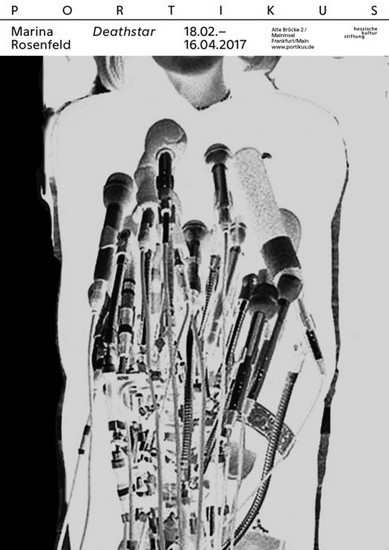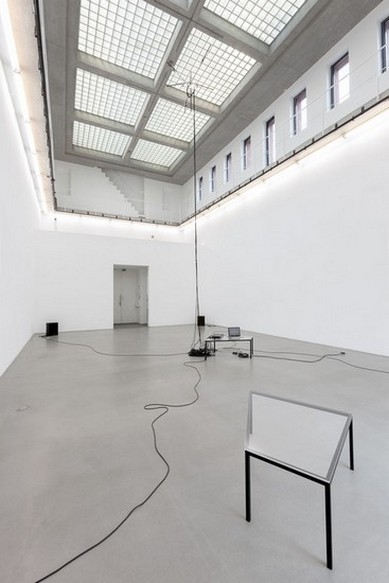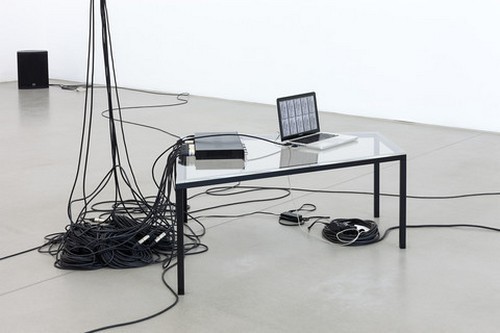Marina Rosenfeld
Deathstar
18 Feb - 16 Apr 2017
MARINA ROSENFELD
Deathstar
18 February –16 April 2017
Portikus is pleased to open Deathstar, the first solo exhibition by Marina Rosenfeld in Germany. Since the 1990s, the New York-based artist and composer has produced a dense oeuvre of sound works, installations, and performative works, often involving the resonance and architecture of monumental spaces. Working at the limits of music composition and performance, but also corralling drawing and notation, Rosenfeld's pieces have foregrounded the complex of material and other conditions that define the situation where music is enacted. Since her early project, the Sheer Frost Orchestra, her all-female electric guitar ensemble, her works for live performers, including teenagers, classical, military and experimental musicians, address structures of transmission and cooperation.
The exhibition title of Marina Rosenfeld's new work for Portikus, Deathstar, refers to an unrealized line of research conducted in the late nineties in the last days of the sound laboratory at AT&T (formerly Bell Labs). Before it was abandoned, researchers explored the possibility of formalizing the subjective and transitory nature of sonic experience through a proprietary microphone configuration and set of calculations. So-called “perceptual soundfield reconstruction” aimed to allow users to reproduce a sensory account of the experience of one space within another. The “death star,” the device's informal nickname, referred more to the appearance of the structure, but the device also pointed to an alternative future, a future where listening was closely tied to cognition and the body.
Marina Rosenfeld takes up the “death star's” idea of environmental recording but inserts it back into a more immediate and complex temporality. The gallery is co-opted as a site of continuous simultaneous recording and playback, a fluid and recursive acoustic environment where a constant production and dispersal of data is subject to a series of delays and to the native distortion of Portikus' architecture. Indeterminacy in this system is a function not of philosophy, but the inability of the apparatus to fully grapple with the quantity and complexity of the signal that is continuously collected, translated, and redistributed through a set of shotgun microphones, an interface and four speakers.
Part echo chamber, part unruly machine, the Deathstar ultimately achieves a kind of legibility through another recursive gesture, the conversion of its collected sound back into notation. In that sense sound is neither an abstraction nor a means to an end, but rather a material condition connected to the formation of music.
On March 31, 2017, pianist Marino Formenti will perform the accumulated notations of the exhibition until that date.
The exhibition was made possible with the financial support of Hessische Kulturstiftung.
Deathstar
18 February –16 April 2017
Portikus is pleased to open Deathstar, the first solo exhibition by Marina Rosenfeld in Germany. Since the 1990s, the New York-based artist and composer has produced a dense oeuvre of sound works, installations, and performative works, often involving the resonance and architecture of monumental spaces. Working at the limits of music composition and performance, but also corralling drawing and notation, Rosenfeld's pieces have foregrounded the complex of material and other conditions that define the situation where music is enacted. Since her early project, the Sheer Frost Orchestra, her all-female electric guitar ensemble, her works for live performers, including teenagers, classical, military and experimental musicians, address structures of transmission and cooperation.
The exhibition title of Marina Rosenfeld's new work for Portikus, Deathstar, refers to an unrealized line of research conducted in the late nineties in the last days of the sound laboratory at AT&T (formerly Bell Labs). Before it was abandoned, researchers explored the possibility of formalizing the subjective and transitory nature of sonic experience through a proprietary microphone configuration and set of calculations. So-called “perceptual soundfield reconstruction” aimed to allow users to reproduce a sensory account of the experience of one space within another. The “death star,” the device's informal nickname, referred more to the appearance of the structure, but the device also pointed to an alternative future, a future where listening was closely tied to cognition and the body.
Marina Rosenfeld takes up the “death star's” idea of environmental recording but inserts it back into a more immediate and complex temporality. The gallery is co-opted as a site of continuous simultaneous recording and playback, a fluid and recursive acoustic environment where a constant production and dispersal of data is subject to a series of delays and to the native distortion of Portikus' architecture. Indeterminacy in this system is a function not of philosophy, but the inability of the apparatus to fully grapple with the quantity and complexity of the signal that is continuously collected, translated, and redistributed through a set of shotgun microphones, an interface and four speakers.
Part echo chamber, part unruly machine, the Deathstar ultimately achieves a kind of legibility through another recursive gesture, the conversion of its collected sound back into notation. In that sense sound is neither an abstraction nor a means to an end, but rather a material condition connected to the formation of music.
On March 31, 2017, pianist Marino Formenti will perform the accumulated notations of the exhibition until that date.
The exhibition was made possible with the financial support of Hessische Kulturstiftung.





